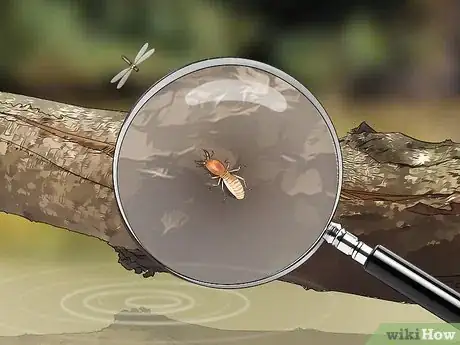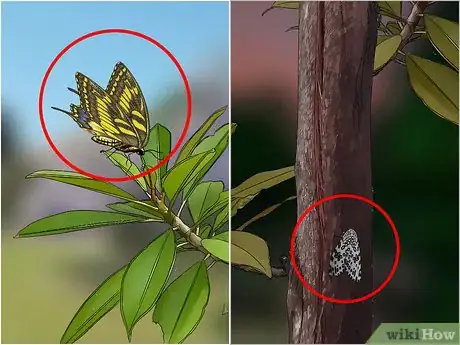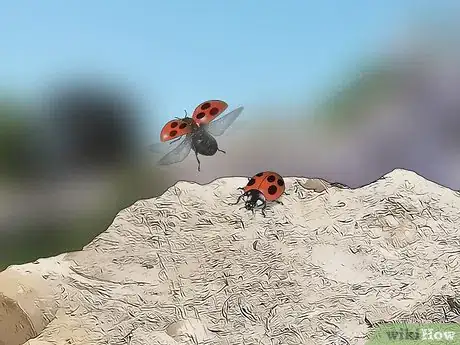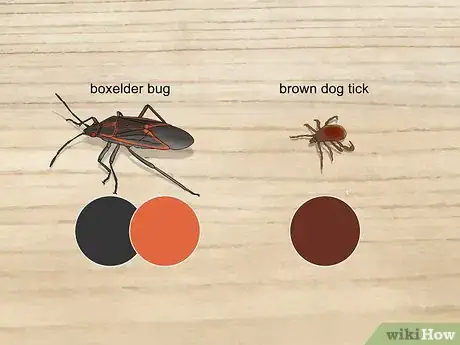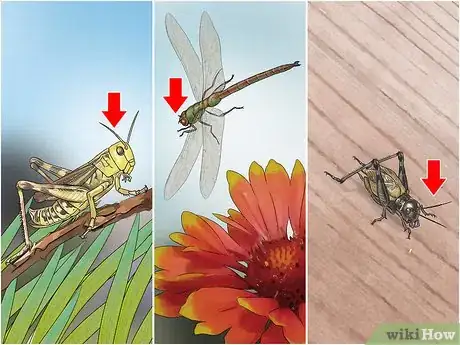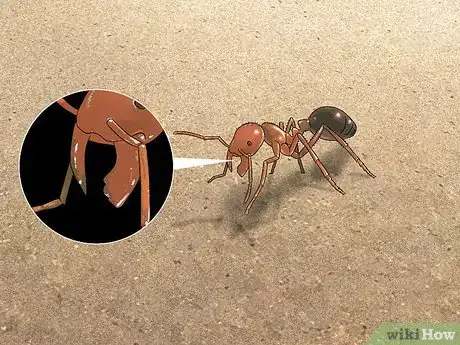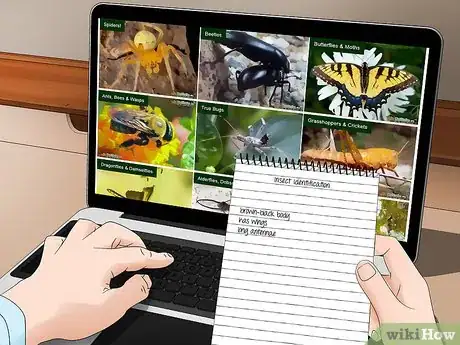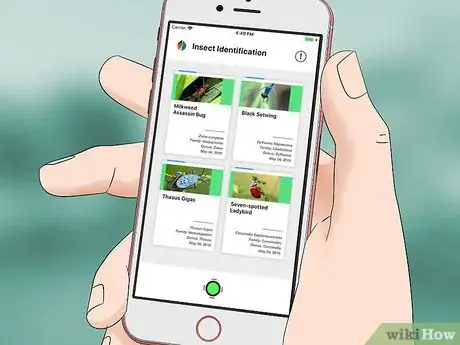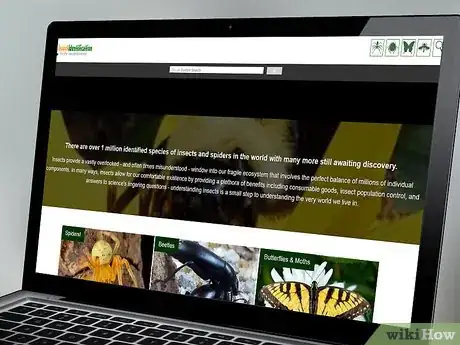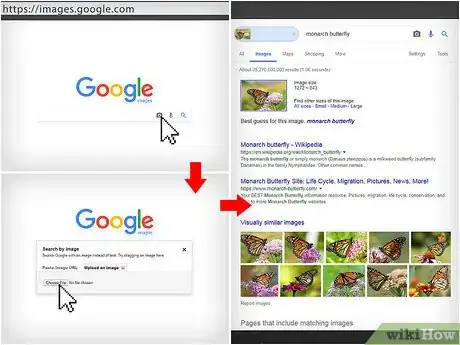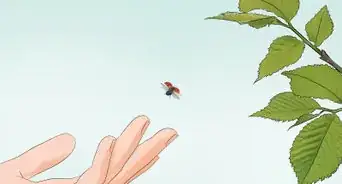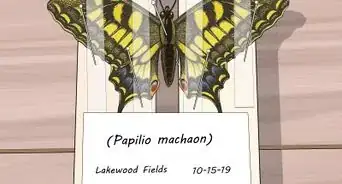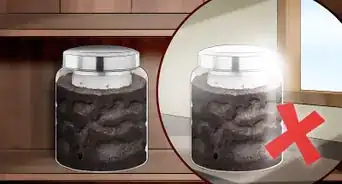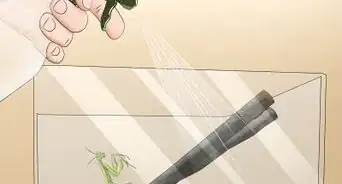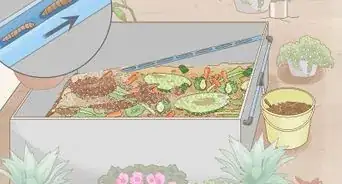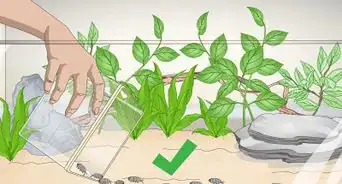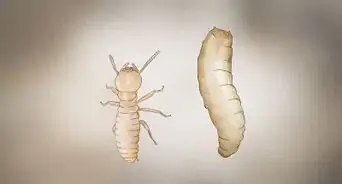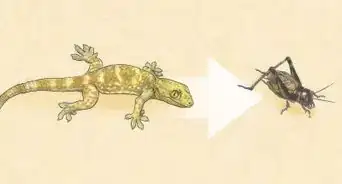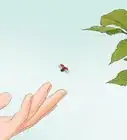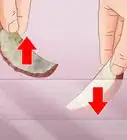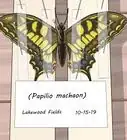This article was co-authored by Shweta Sharma. Shweta Sharma is a Biologist with the U.S. Environmental Protection Agency (EPA). With nearly ten years of experience, she specializes in insect management, integrated pest management, insect behavior, resistance management, ecology, and biological control. She earned her PhD in Urban Entomology and her MS in Environmental Horticulture from the University of Florida. She also holds a BS in Agriculture from the Institute of Agriculture and Animal Sciences, Nepal.
There are 9 references cited in this article, which can be found at the bottom of the page.
This article has been viewed 48,960 times.
Identifying insects is a fun activity and a great way to increase your knowledge of the natural world around you. When you are looking at the insect, observe its different physical characteristics. This will make it easier to narrow down what type of insect you have found. Make use of resources such as apps, online searches, and insect databases to help you find the name of the insect. In no time at all, you’ll be an insect expert!
Steps
Observing the Insect
-
1Take note of where you found the insect. The habitat an insect lives in can help to narrow down what sort of insect you have found. Certain types of insects are predominantly found in swamps, some live in rural areas, and others live in gardens. Note down the general area that you found the insect, such as in the garden, and also record the more specific spot, such as under a log. The more details you record; the easier it is to narrow down what type of insect you have spotted.[1]
-
2Record what time of day you spotted the insect. Different insects are active at different times of the day. Take note of whether it is morning, afternoon, or evening. Butterflies often fly around during the day, mosquitos tend to come out at dusk, and moths usually come out at night.[4]
- If you observed the insect for a long period of time, take note of the time when you first saw it and when it left the area. This can help give you extra clues when you’re searching for the insect in a database.
Advertisement -
3Note if the insect has wings. This is an easy way to narrow down the type of insect that you are looking at. Make a note of whether the insect flies, as some insects have wings but don’t fly. Describe the colour and size of the wings in your notes to help you remember what they looked like.[5]
- Cicadas, bot flies, and ladybugs all have wings.
-
4Record the different colours of the insect. Most insects have at least 2 colours. Identify the main colour of the insect and then record any secondary colours and distinct markings. This will help to narrow down what type of insect you have found.[6]
- The American dagger moth is green, the boxelder bug has orange markings, and brown dog ticks are brown.[7]
-
5Check if the insect has any antennae. Observe as closely as you can what the antennae look like, as this can help give clues as to what insect it is. Note whether the antennae are coloured, plaited, spiky, short, or long.[8]
-
6Observe whether the insect has a moving jaw. Some insects have mouths that open. These insects eat smaller insects or plants. Other insects have straw-like mouths that use to suck food up. If you see an insect eating, record what kind of mouth it has.[11]
- This method of identification is easier to use for larger insects as it is difficult to see the mouth of very small insects.
- Ants and grasshoppers have jaws that open, and mosquitoes and bed bugs have straw-like mouths.[12]
-
7Use your notes to identify the insect in an insect database or dictionary. Enter your data into an online database or search for an insect using a specific characteristic in an insect dictionary. The observations you have made will help you to identify the name and type of insect you have found.
Using Identification Tools
-
1Purchase an app if you want to identify the insect with your camera. If you have a smartphone, using an app is a really quick and easy way to identify the insect. Search the App Store or Google Play for an insect identification app, such as iNaturalist, Insect Identification, or Insects and Spiders. Open the app and then take a photo of the insect in the app. The app will search a database of insects and find the best match.[13]
- This is a great option if you are on a hike and want to be able to identify the insect right away.
-
2Look up the insect in an insect online database or dictionary. These resources can help you to find the name of the specific insect that you are looking at. Use the physical characteristics of the insect and where you found it to look up the insect. Check out your local library or bookstore to find an insect dictionary.[14]
- Access a comprehensive insect database here: https://www.insectidentification.org/
-
3Use a reverse image search online if you have a photo of the insect. Upload a picture of the insect into the search bar on your internet browser on your computer or smartphone and then press search. The results will show you links that match your photo. Click on the links and see if your photo matches the description of the insect.[15]
- Reverse image search here if you are on your computer: https://images.google.com or here if you are on your smartphone:https://reverse.photos
Expert Q&A
-
QuestionCan I upload a picture to identify a bug?
 Shweta SharmaShweta Sharma is a Biologist with the U.S. Environmental Protection Agency (EPA). With nearly ten years of experience, she specializes in insect management, integrated pest management, insect behavior, resistance management, ecology, and biological control. She earned her PhD in Urban Entomology and her MS in Environmental Horticulture from the University of Florida. She also holds a BS in Agriculture from the Institute of Agriculture and Animal Sciences, Nepal.
Shweta SharmaShweta Sharma is a Biologist with the U.S. Environmental Protection Agency (EPA). With nearly ten years of experience, she specializes in insect management, integrated pest management, insect behavior, resistance management, ecology, and biological control. She earned her PhD in Urban Entomology and her MS in Environmental Horticulture from the University of Florida. She also holds a BS in Agriculture from the Institute of Agriculture and Animal Sciences, Nepal.
Biologist Sure! If you're taking a picture of the unidentified insect, know that there are lots of apps right now that can help you. You can also use Google lens to try to identify the little critter!
Sure! If you're taking a picture of the unidentified insect, know that there are lots of apps right now that can help you. You can also use Google lens to try to identify the little critter! -
QuestionWhere is the best spot to look for bugs?
 MilimanCommunity AnswerMost insects seek shelter and are found in clumps of grass, beneath the loose bark of trees, under stones and logs, or beneath leaves and soil debris. These are great places to look, with care. Remember that other creatures like similar places too, like scorpions, snakes and spiders, so be careful when exploring.
MilimanCommunity AnswerMost insects seek shelter and are found in clumps of grass, beneath the loose bark of trees, under stones and logs, or beneath leaves and soil debris. These are great places to look, with care. Remember that other creatures like similar places too, like scorpions, snakes and spiders, so be careful when exploring.
Warnings
- Avoid touching the insects where possible, as this can hurt them.⧼thumbs_response⧽
References
- ↑ https://www.insectidentification.org/identifying.asp
- ↑ https://www.savetootgarookswamp.org/insects-and-invertebrates.html
- ↑ http://www.gardeninsects.com/
- ↑ https://www.insectidentification.org/identifying.asp
- ↑ https://www.insectidentification.org/identifying.asp
- ↑ https://www.insectidentification.org/identifying.asp
- ↑ https://www.insectidentification.org/insect-identification.asp
- ↑ https://www.insectidentification.org/identifying.asp
- ↑ https://www.amentsoc.org/insects/fact-files/antennae.html
- ↑ https://www.amentsoc.org/insects/fact-files/antennae.html
- ↑ https://www.insectidentification.org/identifying.asp
- ↑ http://mentalfloss.com/article/539002/how-identify-insects-just-looking-their-mouths
- ↑ https://itunes.apple.com/us/app/insect-identification/id1380105102?mt=8
- ↑ https://www.insectidentification.org/
- ↑ https://support.google.com/websearch/answer/1325808?hl=en
